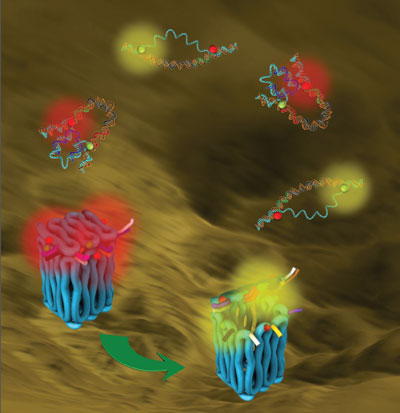| Posted: Apr 20, 2015 | |
Fuzzy and Boolean logic gates based on DNA nanotechnology |
|
| (Nanowerk Spotlight) Logic gates, especially Boolean logic gates, are the fundamental building blocks of today's computers built with silicon-based circuitry; without them, digital information could not be processed. In a way, organisms are – living – computers, too. In that regard, the human body so far is the ultimate 'wet computer' - a highly efficient, biomolecule-based information processor that relies on chemical, optical and electrical signals to operate. | |
| Instead of logic gates made with electronic transistors, the biochemical circuits found in nature are operated with molecules such as DNA: Rather than electrons flowing in and out of transistors, DNA-based logic gates receive and produce molecules as signals. | |
| Research related to molecular logic gates is a fast growing and very active area and molecular devices have become the new frontier in computing. | |
| Researchers in Denmark working on DNA nanotechnology now have designed and synthesized self-assembled DNA complexes that sense two environmental signals and produce a fluorescent output corresponding to the operation of all six Boolean logic gates AND, NAND, OR, NOR, XOR, and XNOR. They report their findings in Small ("Construction of a Fuzzy and Boolean Logic Gates Based on DNA"). | |
| This study could help improvements in the fields of molecular computation and intelligent drug delivery. | |
 |
|
| DNA based booelan and fuzzy logic gates developed by Zadegan et al. enable molecular computation and pave a way for future smart cancer detection and treatment. | |
| "The logic gate senses two different oligonucleotides as inputs and produces fluorescence resonance energy transfer (FRET) as an output signal," Reza M. Zadegan, a post-doctoral researcher in the Department of Molecular Biology and Genetics at Aarhus University, and the paper's first author, tells Nanowerk. "As a proof-of-principle, we demonstrated the implementation of the NOR and fuzzy logic gates in our previously reported 3D DNA origami box. | |
| The scientists point out that integrating logic gates with DNA origami systems opens a vast avenue to many applications in the fields of nanomedicine, biocomputing and bioelectronics. | |
| This is one of very few works that reports production of all Boolean logic gates from a single construct. | |
| Moreover, the team shows that the designed gates can be incorporated into larger DNA structures by implementing the logic gate in their previously reported 3D DNA origami box ("Construction of a 4 Zeptoliters Switchable 3D DNA Box Origami"). | |
| Another important aspect of the work is a fuzzy logic gate system with high fidelity and reliability based on DNA. | |
| "In addition to the molecular logic calculations, our DNA logic gates have been designed to operate with miRNAs as inputs and can thus act as biosensors for specific cancer type detection," notes Zadegan. "Combination of these cancer detection abilities and incorporation of anti-cancer drugs is possible via our DNA origami box, where we can imagine the origami boxes that contain a therapeutic agent – antibody, toxin, enzyme or nucleic acid – caged in. | |
| In such a scenario, the DNA origami box would enter cells and only respond to the cancer cells that are programmed into the biosensor and subsequently deliver and release the drug to kill the tumour cells. This 'smart' targeted process would only respond to a cancerous cell and thus avoid the undesired side effects of the anti-cancer drug on healthy cells. | |
| In addition to the previously mentions applications, fuzzy logic systems like this could help improve our understanding of both biophysical systems and natural controlling mechanisms in organisms. | |
| As Zadegan explains, one can adapt such a system to mimic many of the natural mechanisms in vitro, for instance the binding of multiple miRNAs to regions of an mRNA to down-regulate protein expression in a joined manner. "Our fuzzy logic gate setup in the 3D origami box was designed to respond to miR-21, miR-30c, miR191, and miR-223. All these four miRNAs are up-regulated in colon, pancreas, or prostate cancers." | |
 By
Michael
Berger
– Michael is author of three books by the Royal Society of Chemistry:
Nano-Society: Pushing the Boundaries of Technology,
Nanotechnology: The Future is Tiny, and
Nanoengineering: The Skills and Tools Making Technology Invisible
Copyright ©
Nanowerk LLC
By
Michael
Berger
– Michael is author of three books by the Royal Society of Chemistry:
Nano-Society: Pushing the Boundaries of Technology,
Nanotechnology: The Future is Tiny, and
Nanoengineering: The Skills and Tools Making Technology Invisible
Copyright ©
Nanowerk LLC
|
|
|
Become a Spotlight guest author! Join our large and growing group of guest contributors. Have you just published a scientific paper or have other exciting developments to share with the nanotechnology community? Here is how to publish on nanowerk.com. |
|
